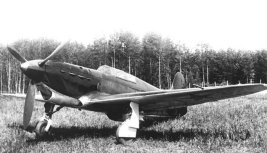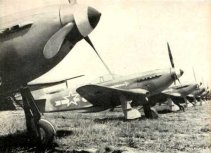
Yakovlev 1/7
First of the modern Yak fighters, the Yak-1 came into service just in time to meet the German invasion in 1941. Agile and fast, the Yak was t he best of the new Soviet fighters and could equal a Bf 109 or Fw 190 in a dogfight, in addition to being a useful ground attacker. The Yak-7, originally designed as a trainer, was hastily converted for fighter duties. Both aircraft evolved into better designs, the later Yak-3 and Yak-9.
Yak began the project for a single-seat lightweight fighter before the war, and the prototype I-26 first flew in January 1940. Emphasis was on the use of cheap materials (using composite wooden skins and fabric covering) and integral armament, with a nose-mounted cannon. The aircraft showed immediate promise and was rushed into production even before trials were complete. By March 1942, the Yak-1 was being produced in a lightened form for increased agility.
The acute shortage of fighters meant that the trainer Yak-7 was converted to combat use, including artillery spotting and fighter duties. The aircraft was also fitted with rockets for ground attack and tank-busting and cameras for reconnaissance. The Yak-7R even mounted a rocket engine in the tail. Best of the Yak-1s was the Yak-1M, which was quickly redesignated the Yak-3. This aircraft gave its pilots a much improved field of vision and was one of the war's most agile fighters.
The early Yaks were a vital stopgap between obsolete designs like the I-16 and the excellent later Yaks and Lavochkin La-5s with which the Soviet Union won the air war on the Eastern Front.
 |
 |
 |
| Finest of the Yak-1s was the Yak-1M, which soon evolved into the Yak-3. Reduced weight helped give agility, although oil cooling was problematic. |
These pilot on the Kharkov front shot down 15 enemy aircraft in a week in May 1942. The Yaks gave the USSR air superiority after the appalling defeats inflicted in 1941. |
More than 8700 Yak-1s and 6300 Yak-7s were produced in total. Yaks were by far the most important fighters in the Soviet arsenal. |
|
Yakovlev 1/7 (Technical Specification) |
| Role |
Single-seat fighter and fighter-bomber |
| Manufacturer |
Yakovlev |
| Maximum Speed |
530 kmh (329 mph) |
| Maximum Range |
700 km (435 mil) |
| Ceiling |
9,000 meters (29,500 feet) |
Weight
Empty
Maximum Takeoff |
2,550 kg (5,610 lbs)
3,130 kg (6,886 lbs) |
Dimensions
Wingspan
Length
Wing Area |
10.00 meters (32 ft 10 in)
8.48 meters (27 ft 9 in)
17.15 square meters (185 sq ft) |
| Engines |
One Klimov M-105 V-12 liquid-cooled engine which provides 782-kW (1,050 hp) |
| Armament |
One 20 mm (0.79 in) ShVAK cannon
One or two 12.7 mm (0.50 cal) machine-guns
Six RS-82 rockets could be carry in wing racks |
Photo Gallery
Click here to submit your photo
| Have A Passion For Aircraft? |
Subscribe to our 14 series FREE newsletter
delivered weekly on World War 2 Aircraft factfile... |
| NB:- We hate spam as much as you do, so your email address will NEVER be shared with or sold to anyone else. That's a Guarantee. |
|
|





